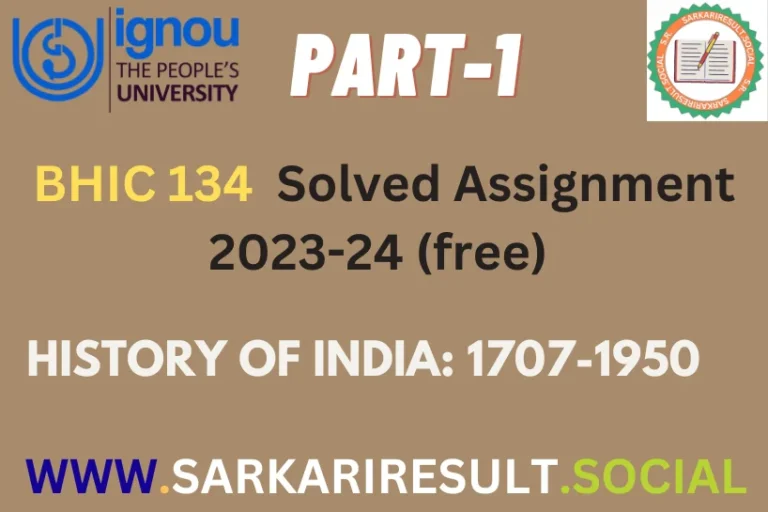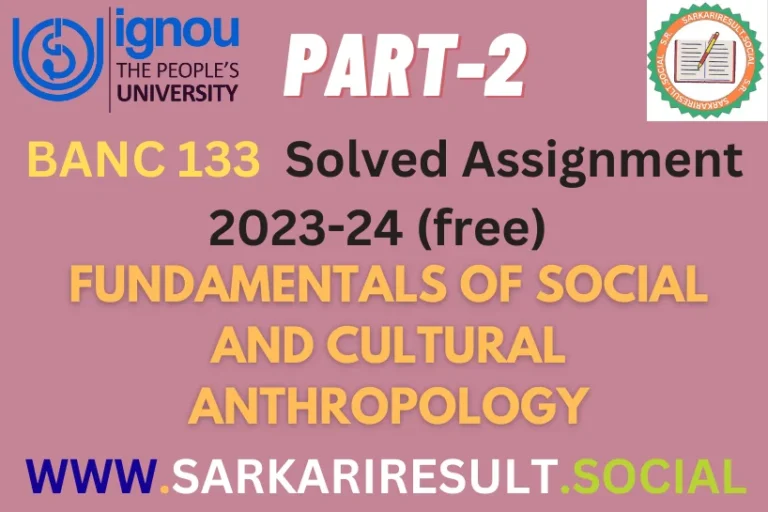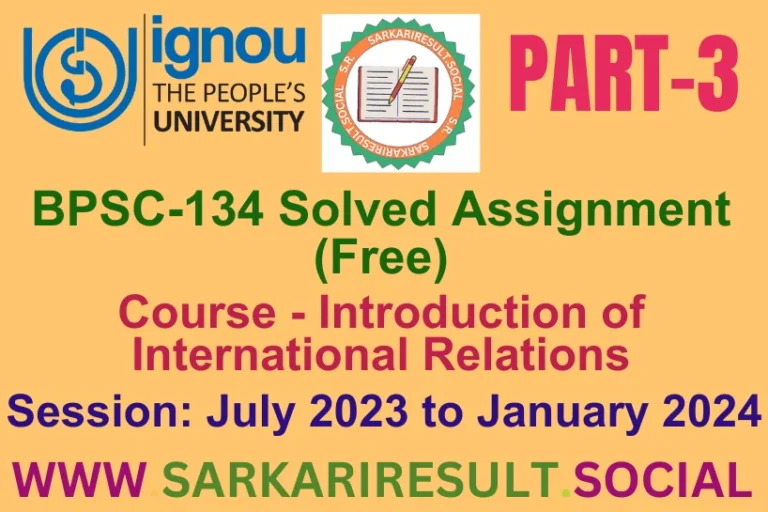Check BPAG-171 IGNOU solved assignment 2022-2023 (free) before Last Date
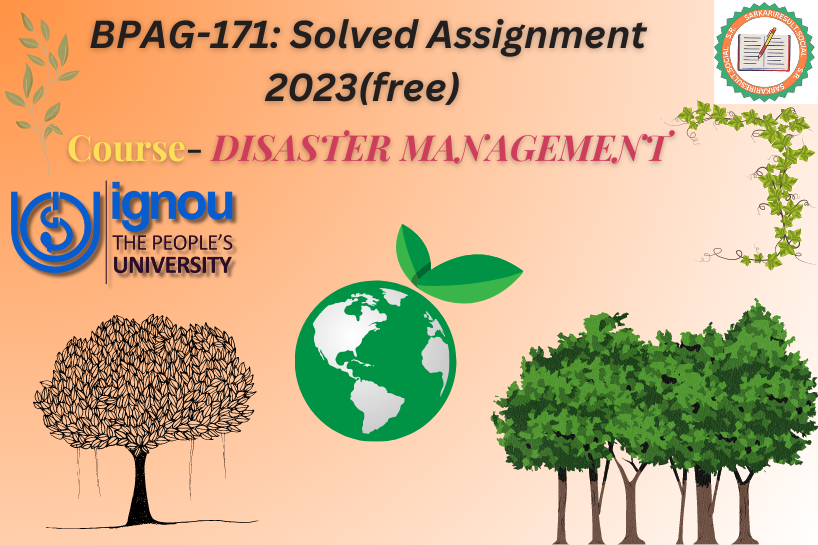
BPAG-171 IGNOU solved assignment 2022-2023 (free)
Looking for BPAG-171 IGNOU solved assignment ? Don’t worry, we are providing it in this post. BPAG-171 is a six-credit course offered by IGNOU that focuses on Disaster Management. It covers the principles, concepts, and practices related to managing disasters, including risk assessment, preparedness, response, and recovery. The course aims to provide students with a comprehensive understanding of disaster management and the roles of different stakeholders in effectively addressing and mitigating the impacts of disasters.
BPAG-171 Assignment Important Details 2023
| Programme code | BACHELOR OF ARTS PROGRAMME |
|---|---|
| Assignment Code | BPAG-171 |
| Subject Title | DISASTER MANAGEMENT |
| Last date to submit assignment (extended) | 15 May 2023 |
| Eligibility | July 2022 session students and January 2023 session students |
| Official Last date to submit | 30 April 2023 (over) |
| Total Marks | 100 Marks |
| Number of Parts to complete | 3 parts (Assignment A, Assignment B and Assignment C) |
| Number of questions | 10 |
Questions and Answers Solved (BPAG-171)
Assignment – A
Q.1 Define vulnerability and various factors that cause it. (500 words)
Ans. Vulnerability refers to a state or condition of being susceptible to harm, damage, or attack. It is a characteristic that exposes individuals, systems, or entities to potential risks or threats. Understanding the factors that contribute to vulnerability is crucial in disaster management to effectively mitigate risks and protect communities.
Social Factors:
Social vulnerabilities stem from factors such as poverty, inequality, social exclusion, and limited access to resources. Disadvantaged communities with inadequate housing, insufficient healthcare, and limited social support networks are more vulnerable to the devastating effects of disasters. Lack of social cohesion and community engagement can hinder preparedness and response efforts.
Geographic Factors:
Geographical vulnerabilities arise from the location and characteristics of a community. Proximity to coastlines, flood-prone areas, fault lines, or regions prone to wildfires increases vulnerability to specific types of disasters. Additionally, areas with limited infrastructure, such as roads, bridges, or evacuation routes, face higher risks during emergencies.
Environmental Factors:
Environmental vulnerabilities relate to the condition and resilience of natural systems. Deforestation, soil erosion, loss of wetlands, and degradation of ecosystems can amplify the impacts of disasters. Communities heavily reliant on specific resources, such as agriculture or fisheries, are particularly vulnerable to climate-related events.
Economic Factors:
Economic vulnerabilities are influenced by factors such as poverty, unemployment, and reliance on specific industries. Limited economic resources and livelihood opportunities can hinder recovery efforts and exacerbate vulnerabilities in the aftermath of disasters. Fragile economies and high levels of debt can also hamper a community’s ability to invest in preventive measures or resilience-building initiatives.
Infrastructure Factors:
Infrastructure vulnerabilities refer to the condition and resilience of physical structures and systems. Aging infrastructure, inadequate building codes, and poor maintenance practices increase susceptibility to damage during disasters. Critical infrastructure such as power grids, water supply systems, and transportation networks can become points of vulnerability if not designed or maintained properly.
Governance Factors:
Governance vulnerabilities relate to the effectiveness of institutions, policies, and decision-making processes. Weak governance, corruption, or lack of coordination among stakeholders can hinder disaster preparedness, response, and recovery efforts. Inclusive and participatory governance structures are essential for identifying vulnerabilities, implementing risk reduction measures, and ensuring equitable distribution of resources during emergencies.
Knowledge and Awareness Factors:
Lack of knowledge, awareness, and education about disaster risks can contribute to vulnerability. Limited understanding of evacuation procedures, preparedness measures, or early warning systems can impede timely and effective responses. Education and awareness programs play a critical role in empowering communities to better understand and address their vulnerabilities.
Interdependencies:
Interdependencies between sectors and systems can create vulnerabilities. For example, disruptions in the transportation or communication networks can hinder emergency response operations. Interconnected supply chains can be vulnerable to disruptions, affecting the availability of critical resources during disasters.
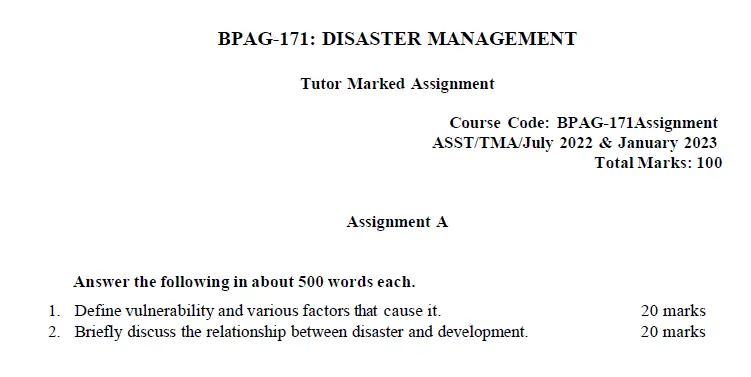
Q.2 Briefly discuss the relationship between disaster and development. (500 words)
Ans. The relationship between disaster and development is a complex and intertwined one. Disasters can have significant impacts on development efforts, while the state of development, in turn, can influence vulnerability to disasters. Understanding this relationship is crucial for promoting sustainable development and building resilience in the face of disasters.
Impacts of Disasters on Development:
Disasters can have severe impacts on social, economic, and environmental aspects of development. They can cause loss of lives, displacement of populations, destruction of infrastructure, disruption of essential services, and loss of livelihoods. These impacts can setback development progress, hinder economic growth, and exacerbate poverty and inequality. The recovery and reconstruction process following a disaster can strain resources and divert funds from long-term development projects.
Vulnerability and Development:
The level of development in a region can influence its vulnerability to disasters. Low-income communities and marginalized populations are often more vulnerable due to limited access to resources, inadequate infrastructure, and weak governance. Development gaps can create disparities in resilience, with wealthier communities having better capacity to prepare for and recover from disasters. Thus, addressing development inequalities is crucial for reducing vulnerability and promoting resilience.
Sustainable Development and Disaster Risk Reduction:
Integrating disaster risk reduction (DRR) into development planning is essential for promoting sustainable development. By identifying and addressing vulnerabilities, incorporating climate change adaptation measures, and implementing risk reduction strategies, development initiatives can become more resilient to disasters. Investing in resilient infrastructure, early warning systems, and community preparedness can contribute to sustainable development goals and reduce disaster impacts.
Climate Change and Development:
Climate change exacerbates the relationship between disaster and development. Rising global temperatures and changing weather patterns lead to an increased frequency and intensity of extreme events such as hurricanes, droughts, floods, and heatwaves. These climate-related disasters pose significant challenges to development efforts, particularly in vulnerable regions. Mitigating climate change through greenhouse gas reduction strategies and adaptation measures is crucial for sustainable development and reducing disaster risks.
Disaster Risk Management and Development:
Effective disaster risk management (DRM) is integral to sustainable development. This involves proactive measures such as hazard mapping, early warning systems, emergency preparedness, and response planning. By integrating DRM into development policies and practices, communities can reduce their vulnerability to disasters and enhance their capacity to recover and rebuild.
Resilience and Development:
Resilience is the ability of communities and systems to withstand and recover from shocks and stresses. Building resilience is a fundamental aspect of sustainable development. It involves strengthening social, economic, and environmental systems to absorb, adapt, and transform in the face of disasters. By investing in resilient infrastructure, promoting social cohesion, and enhancing ecosystem services, development efforts can contribute to building resilient communities.
Knowledge and Capacity Building:
Enhancing knowledge and capacity at all levels is vital for the relationship between disaster and development. This includes raising awareness about disaster risks, promoting education and training on disaster management, and facilitating the exchange of best practices. Strengthening local institutions, fostering community participation, and empowering vulnerable populations are crucial for effective disaster response and sustainable development.
The relationship between disaster and development is a dynamic and reciprocal one. Disasters can hinder development progress, exacerbate vulnerabilities, and undermine socio-economic and environmental systems. On the other hand, development approaches that integrate disaster risk reduction, climate change adaptation, and resilience-building can contribute to sustainable development and reduce the impacts of disasters. By recognizing and addressing the interplay between disaster and development, societies can work towards building more resilient, inclusive, and sustainable futures.
Assignment – B
Q.3 Write a note on the National Policy on Disaster Management, 2009 and National Disaster Management Plan, 2016. (250 words)
Ans. The National Policy on Disaster Management, 2009, and the National Disaster Management Plan, 2016, are key documents that outline India’s approach to disaster management. These documents provide a comprehensive framework for disaster preparedness, mitigation, response, and recovery at the national, state, district, and community levels.
The National Policy on Disaster Management, 2009, aims to promote a proactive and holistic approach to disaster management. It emphasizes the importance of prevention, mitigation, and preparedness measures to minimize the impact of disasters. The policy focuses on strengthening institutional mechanisms, enhancing early warning systems, promoting risk reduction strategies, and building a culture of safety and resilience. It highlights the need for multi-stakeholder collaboration and community participation in disaster management efforts. The policy also emphasizes the importance of integrating disaster risk reduction into development plans and programs.
The National Disaster Management Plan, 2016, is a detailed framework that operationalizes the National Policy on Disaster Management. It provides guidelines and standard operating procedures for various phases of disaster management, including prevention, preparedness, response, and recovery. The plan outlines the roles and responsibilities of various government agencies, departments, and stakeholders involved in disaster management. It emphasizes the need for coordination, information sharing, and capacity building at all levels. The plan also focuses on specific sectors such as agriculture, health, infrastructure, and communication, providing sector-specific strategies for disaster management. It highlights the importance of integrating technology, early warning systems, and information management in disaster response and recovery.
Both the National Policy on Disaster Management, 2009, and the National Disaster Management Plan, 2016, prioritize the safety and well-being of communities in the face of disasters. These documents emphasize the importance of a proactive and comprehensive approach to disaster management, integrating risk reduction, preparedness, response, and recovery measures. They provide a roadmap for government agencies, non-governmental organizations, and communities to work together in a coordinated manner to build resilience and reduce the impacts of disasters in India.

Q.4 List out the statutory provisions for mainstreaming disaster risk reduction. (250 words)
Ans. Statutory provisions in India play a crucial role in mainstreaming disaster risk reduction (DRR) across sectors. Here are some key provisions:
- Disaster Management Act, 2005: Mandates the integration of DRR into development plans, policies, and programs at all levels. Establishes National, State, and District Disaster Management Authorities.
- National Policy on Disaster Management, 2009: Emphasizes mainstreaming DRR in all sectors, including development planning, infrastructure, land use planning, and environmental management.
- National Disaster Management Plan, 2016: Provides sector-specific guidelines for mainstreaming DRR, ensuring its integration into policies and programs in sectors like agriculture, health, education, infrastructure, and communication.
- Environmental Impact Assessment (EIA): Under the Environment (Protection) Act, 1986, project proponents must assess and mitigate disaster risks through hazard identification, risk assessment, and incorporating mitigation measures.
- Building Codes and Regulations: National Building Code of India and state-level codes incorporate disaster-resistant features, promoting safer construction practices.
- Land Use Planning: Town and Country Planning Acts at the state level mandate integrating DRR considerations into land use planning, including hazard zoning and compliance with building codes.
- Education and Awareness: Right to Education Act, 2009, emphasizes DRR education in school curricula, raising awareness, and building capacity among students and communities.
- Sectoral Guidelines: Various sectors have their own guidelines promoting the integration of DRR, incorporating risk assessments, early warning systems, and disaster-resilient design principles.
These statutory provisions facilitate the mainstreaming of DRR by ensuring its integration into sectoral plans, policies, and programs. By incorporating DRR considerations, India aims to enhance resilience, reduce vulnerability, and achieve sustainable development in the face of disasters.
Also Check : BGDG 172 IGNOU solved assignment 2023 (free)
Q.5 Examine the case study of ‘The Indian Ocean Tsunami, 2004’. (250 words)
Ans. The Indian Ocean Tsunami, which occurred on December 26, 2004, was one of the deadliest natural disasters in recorded history. Triggered by an undersea earthquake off the coast of Sumatra, Indonesia, the tsunami affected several countries across the Indian Ocean region. Examining this case study highlights the devastating impacts of the event and the subsequent efforts in disaster management.
The tsunami claimed the lives of an estimated 230,000 people in 14 countries. Communities were swept away, infrastructure was destroyed, and livelihoods were disrupted. The scale of the disaster exposed vulnerabilities in the affected regions, including inadequate early warning systems, limited preparedness measures, and insufficient infrastructure to withstand the massive waves.
In the aftermath of the disaster, significant efforts were made to strengthen disaster management in the region. The Indian Ocean Tsunami Warning System (IOTWS) was established to provide early warnings for tsunamis. It includes a network of seismic monitoring stations, deep-sea sensors, and communication systems to detect and disseminate alerts. This initiative has greatly enhanced the region’s ability to respond to future tsunami threats.
Additionally, countries affected by the tsunami focused on improving disaster preparedness and response capabilities. This involved training and capacity building for emergency services, enhancing public awareness and education on tsunami risks, and developing evacuation plans and drills. Collaborative efforts were also undertaken to strengthen regional cooperation in disaster management, knowledge sharing, and resource mobilization.
Assignment – C
Q.6 What do you mean by epidemics? (100 words)
Ans. Epidemics refer to the occurrence of a significantly higher number of cases of a particular infectious disease within a specific population or geographic area than what is typically expected. These outbreaks can rapidly spread and affect a large number of individuals, posing public health challenges. Epidemics are characterized by a sudden increase in the incidence of the disease, often exceeding the capacity of healthcare systems to respond effectively. Common examples of epidemics include influenza outbreaks, the Ebola virus disease epidemic, or the COVID-19 pandemic. Controlling epidemics typically involves implementing measures such as disease surveillance, infection prevention and control, public awareness campaigns, and timely interventions to reduce transmission and protect public health.
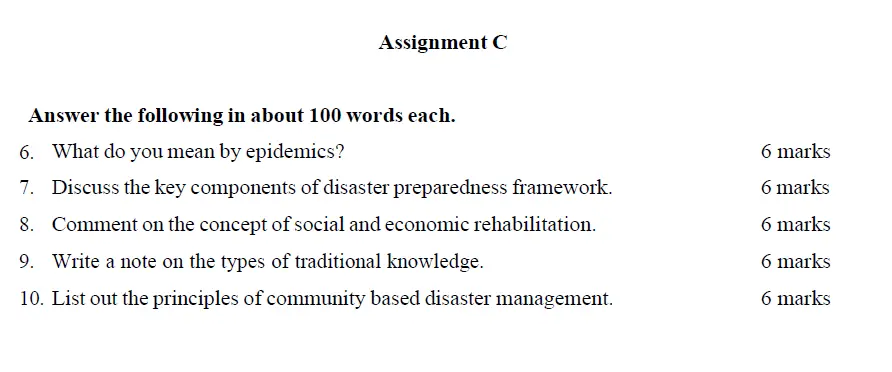
Q.7 Discuss the key components of disaster preparedness framework. (100 words)
Ans. The key components of a disaster preparedness framework include risk assessment, early warning systems, emergency planning, capacity building, and public awareness.
Risk assessment involves identifying potential hazards, assessing their probability and potential impact.
Early warning systems provide timely information to alert communities and authorities about impending disasters.
Emergency planning involves developing response protocols, coordination mechanisms, and resource allocation strategies. Capacity building focuses on enhancing the skills and capabilities of individuals, organizations, and systems involved in disaster response.
Public awareness campaigns aim to educate communities about potential risks, preparedness measures, and evacuation procedures.
Together, these components form a comprehensive disaster preparedness framework that enables proactive measures and effective responses to minimize the impact of disasters.
Q.8 Comment on the concept of social and economic rehabilitation. (100 words)
Ans. Social and economic rehabilitation refers to the process of restoring and rebuilding the social and economic fabric of a community or population affected by a disaster or crisis. It involves addressing the physical, psychological, social, and economic needs of individuals and communities, with the aim of restoring their well-being and promoting sustainable recovery. Social rehabilitation focuses on restoring community structures, fostering social cohesion, and providing psychosocial support. Economic rehabilitation aims to revive livelihoods, promote economic recovery, and enhance resilience through measures such as livelihood support, skill training, access to finance, and the revitalization of local economies.
Q.9 Write a note on the types of traditional knowledge. (100 words)
Ans. Traditional knowledge encompasses a wide range of knowledge systems developed by indigenous and local communities over generations. It can be categorized into various types. Ecological knowledge pertains to the understanding of local ecosystems, including biodiversity, resource management, and sustainable practices. Agricultural knowledge encompasses traditional farming techniques, seed saving, and crop diversity. Medicinal knowledge involves the use of traditional remedies and healing practices. Cultural knowledge includes traditional arts, crafts, rituals, and storytelling. Practical knowledge relates to skills and techniques for daily living, such as shelter construction or food preservation. Each type of traditional knowledge holds valuable insights and practices that contribute to the cultural heritage and sustainable development of communities.
Q.10 List out the principles of community based disaster management. (100 words)
Ans. The principles of community-based disaster management include:
- Community participation: Engaging communities in decision-making, planning, and implementation processes.
- Local knowledge and capacity: Recognizing and leveraging local knowledge, skills, and resources.
- Vulnerability and capacity assessment: Conducting assessments to identify community vulnerabilities and capacities for effective planning and response.
- Risk reduction and resilience: Implementing measures to reduce risks, enhance resilience, and promote sustainable development.
- Gender and social inclusion: Addressing the specific needs and vulnerabilities of marginalized groups, promoting inclusivity and gender equality.
- Collaboration and partnerships: Fostering cooperation among stakeholders, including government, NGOs, and community-based organizations.
BPAG-171: DISASTER MANAGEMENT (FAQs)
Q.1 What is vulnerability in disaster management?
Ans: Vulnerability refers to the susceptibility of individuals, communities, or regions to the impacts of disasters, often influenced by various factors such as socio-economic status, environmental conditions, infrastructure, and access to resources.
Q.2 What are the factors that contribute to vulnerability in disaster-prone areas?
Ans: Factors contributing to vulnerability include poverty, inadequate infrastructure, lack of preparedness measures, limited access to education and healthcare, environmental degradation, population density, and social inequalities.
Q.3 What is the National Policy on Disaster Management, 2009?
Ans: The National Policy on Disaster Management, 2009 is a comprehensive framework that outlines the government’s strategies, objectives, and institutional mechanisms for effective disaster management in India.
Q.4 Can you highlight the key objectives of the National Disaster Management Plan, 2016?
Ans: The National Disaster Management Plan, 2016 aims to provide a systematic and coordinated approach to disaster management. It focuses on prevention, mitigation, preparedness, response, and recovery, with the objective of reducing the impact of disasters and enhancing resilience.
Q.5 Examine the case study of ‘The Indian Ocean Tsunami, 2004.’
Ans: The Indian Ocean Tsunami, 2004, was a devastating disaster triggered by an undersea earthquake. It caused widespread destruction in multiple countries, resulting in loss of lives, displacement, and damage to infrastructure. The case study explores its causes, impacts, and response efforts.
Q.6 What do you mean by epidemics?
Ans: Epidemics refer to the occurrence of a significant increase in the number of cases of a particular disease in a specific population or geographical area, surpassing what is normally expected.
Q.7 Discuss the key components of the disaster preparedness framework.
Ans: The key components of a disaster preparedness framework include early warning systems, emergency planning, resource management, capacity building, community engagement, training and drills, and coordination among relevant stakeholders.
Q.8 Comment on the concept of social and economic rehabilitation.
Ans: Social and economic rehabilitation focuses on restoring and improving the social and economic well-being of individuals and communities affected by disasters. It involves measures such as providing access to basic services, livelihood support, psychological assistance, and rebuilding infrastructure.
Q.9 Write a note on the types of traditional knowledge.
Ans: Traditional knowledge includes indigenous practices, techniques, and wisdom that have been passed down through generations. In the context of disaster management, it can encompass indigenous forecasting methods, local building techniques, traditional ecological knowledge, and community-based disaster response practices.
Q.10 List out the principles of community-based disaster management.
Ans: The principles of community-based disaster management include community participation, local ownership, inclusivity, capacity building, knowledge sharing, resilience-building, and integration of traditional knowledge with modern approaches.


